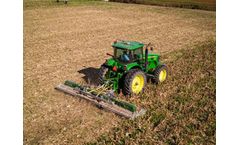Refine by
Maize Yields Articles & Analysis
39 news found
The shifting dynamics of global weather patterns have brought a new layer of complexity to agricultural practices. If you’re in farming, you’ve likely noticed the growing unpredictability of our seasons. Addressing these shifts requires a combination of innovative strategies, practical adaptations, and long-term planning. Our way of life is being tested by increasingly erratic weather ...
Years with lower corn prices lead to many farmers making soybeans a bigger part of their crop plan. The Maximum Farming System® can help make the most of such changes and provide optimal fertilizer management, which varies by crop. For example, corn benefits dramatically from in-furrow fertilization that provides sufficient levels of tissue phosphorus during early growth stages to maximize ...
Division continues to successfully commercialize its product pipeline in key markets, including XtendFlex soybeans and SmartStax PRO corn in North America, and Intacta 2 Xtend soybeans in South America Successful launches demonstrate progress towards mid-term growth targets in Crop Science and strength of the division’s innovation, digital transformation and sustainability capabilities ...
ByBayer AG
Armed with a Field Crops Technology degree from NC State University, the fifth generation farmer came home after college, and several months later, had an opportunity to start a vegetable farming venture with his life-long friend, Walker Shelton. “This year, Walker and I grew 160 acres of cucumbers and 15 acres of specialty peppers that are drip irrigated thanks to a great water supply from ...
The 2019 growing season came to an abrupt end across large parts of the U.S. Plains and Upper Midwest between October 11 and October 14, 2019, as a dramatic early-season blizzard developed across North Dakota and unusual cold spread across many states. Snow accumulations of up to 36” occurred in North Dakota in tandem with very strong winds, and about half of the state was covered with at ...
On Monday, August 12th, 2019 the USDA increased its national estimate of the end of season corn yield (to be reported in January 2020) from 166.0 bpa to 169.5 bpa, an increase of 3.5 bpa. USDA’s estimate of corn planted acreage was revised downwards by less than 2% to 90.0 million acres, versus an industry expectation of 88.0 million acres. Estimated corn production was almost unchanged at ...
A University of Florida Institute of Food and Agricultural Sciences researcher will lead a nearly $1 million project to increase worldwide wheat yield potential to help feed an anticipated 9.5 billion people globally by the year 2050. To do this, Md Ali Babar, a UF/IFAS agronomy assistant professor and his team of researchers, hope to increase the harvest index from 45 to 60 percent, which ...
Growers worried about delayed planting for corn, take heart – late-planted corn sometimes has reaped better yields than early planted corn, says an agronomist in the College of Food, Agricultural, and Environmental Sciences at The Ohio State University. It’s true that the optimal time to get corn planted in southern Ohio is between April 10 and May 10 and in northern Ohio between ...
High input costs coupled with low grain prices anticipated in 2016 means that growers have to make smarter, calculated choices to grow profitable crops this year. Also important is the need to build and maintain healthy soils to help ensure good water quality, said Randall Reeder, a retired Ohio State University Extension agricultural engineer. Reeder is an organizer of the annual Conservation ...
Dutch silage maize farmers can increase their yield in the long term by using earlier varieties. ...
Over two growing seasons, the researchers compared pest damage in maize grown under the exclosures with damage to maize grown in identically sized neighbouring sections of the maize field. ...
Despite the heavy rains that hit the region early during the growing season this year, soybeans in the majority of test plots planted by researchers with the College of Food, Agricultural, and Environmental Sciences at The Ohio State University still managed to beat expectations. In fact, in four of the six test sites for the 2015 Ohio Soybean Performance Test, soybeans averaged over 70 bushels ...
Vermicomposting livestock manure with maize can increase agricultural benefit by 304%, shows a new study. The combination of increased crop yield and the additional earthworms produced as a result of the process led to a substantial increase in output compared to a traditional composting system. ...
The USDA’s latest report on agricultural supply and demand for the 2014-2015 marketing year suggests supplies will continue to be on the tight side for key U.S. crops despite record harvests, the American Farm Bureau Federation said today. “The most interesting feature of today’s World Agricultural Supply and Demand Estimates Report is the projected corn yield of 167.4 bushels ...
Many factors contribute to the excess phosphorous that stimulates algal systems in bodies of water such as Lake Erie. Sources of excess phosphorous include urban stormwater, factories, sewers, household wastes and lawn fertilizer, and in some areas runoff from fertilizers or manure applied to fields. Fortunately, many farmers are already doing their part to improve water. For example, cover ...
Overall, the study’s authors say, the likelihood of a sharp drop in yields of crops vital to food supply, such as wheat and maize, is “not very high” − but global warming does markedly increase the chance of such events happening. ...
Growers wanting to learn more about managing herbicides, fungicides and resistance, corn yield optimization, corn seed treatments and high-input soybean production can take advantage of a series of free webinars taught by agronomists from Ohio State University’s College of Food, Agricultural, and Environmental Sciences. The webinars offer participants insight into some of the ...
Growers wanting to learn more about corn yield optimization, corn seed treatments and high-input soybean production can take advantage of a series of upcoming webinars taught by agronomists from Ohio State University’s College of Food, Agricultural, and Environmental Sciences. The webinars offer participants insight into some of the key issues in grain production including ...
Following some of the best years ever for growing row crops, an agricultural economist advised farmers to prepare for several years of lower prices, at a workshop at the American Farm Bureau Federation’s 95th Annual Convention. “The last six years have been extraordinary years if you are a row crop producer,” said Matthew Roberts, an associate professor at Ohio State ...
Welcome to rural policing—find an easy target. Maize yields and quality The maize is coming off really well with yields of between 16 and 17 tonnes per acre, dry matter between 35% and 40% and a starch level of 31%. ...












